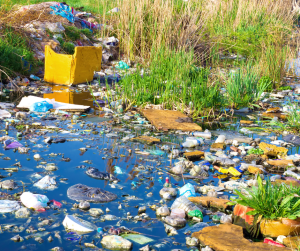Micro- and nanoplastics (MNPs) are ubiquitous in the environment. This includes the water we drink, the food we eat and the air we breathe. Microplastics are tiny plastic materials ranging in size from 1 µm (100 times smaller than a grain of sand) to 5 mm (the size of a pencil eraser). Nanoplastics are particles smaller than 1 µm.
Most MNPs in the environment are from the breakdown of larger plastic pollution. An estimated 22 million pounds of plastic debris enters the Great Lakes each year, with 11.6 million pounds entering Lake Michigan. This plastic debris can break down into microplastics. Another important source of MNPs in the environment is from wastewater treatment plants (WWTP). Microplastics collected at these plants from the community at large (e.g., washing machine discharge containing synthetic fibers) are in the discharged treated water as well as in biosolids spread on farmland. WWTP effluent discharges millions to billions of microplastic particles to the environment every day. Hundreds of millions more particles are estimated to be transported to our rivers, streams, and lakes from biosolids applied to farmland in Wisconsin every year.
Once in the environment, MNPs can make their way into food chains (particularly fish and other seafood) and our drinking water sources. One published study estimated that the typical American diet leads to the ingestion of 39,000-52,000 microplastic particles per year from seafood, sugars, honey and alcohol alone.
Bottled water in the US is estimated to have around 90 microplastic particles per liter, but a recent study that looked at both nano- and microplastics found 240,000 particles per liter, 90% of which were nanoplastics. Typical tap water in the US contains about 4 microplastic particles per liter.

Due to this exposure, MNPs have been found throughout the human body, including in the human nervous, respiratory, cardiovascular, and reproductive systems. For example, a recent study found that the typical adult brain had the equivalent of a plastic spoon’s worth of micro- and nanoplastics.
The health effects of microplastics in our body are largely unknown right now, but there are three primary concerns. First, due to their physical presence as a foreign object, microplastics may interfere with normal cell and tissue function. Second, microplastics can have toxic additives like flame retardants or plasticizers that are harmful once introduced into the body. Third, microplastics can absorb toxic pollutants in the environment like PCBs, PFAS and heavy metals, which can cause harm once in the body.
Numerous laboratory and animal studies have reported harmful effects of microplastic exposure. These studies, combined with the knowledge that microplastics in our food, air and water are getting into our bodies, create a need to better understand the human health effects of microplastics.
Recent studies have found a correlation between increased MNP concentrations in the body and adverse health outcomes, suggesting a need to better understand the role of microplastic exposure as a driver of health conditions. In one study, patients with carotid artery disease were found to have more MNPs in their arteries than those without disease. In another study, people with dementia were reported to have 10 times more MNPs in their brain than those without dementia. Alarmingly, this study also found that MNP concentrations in the body increased by 50% between 2016 and 2024, mirroring the increase in plastics in the environment.
As MNPs are a pervasive threat to both human health and ecosystems, there is no single solution to address this widespread problem. Policy changes are needed at the local, state, and federal level, and across sectors, to tackle this issue. The Alliance for the Great Lakes has created an advocacy toolkit to address MNP pollution through policy solutions. These policy solutions include banning single-use foam and plastic bags, requiring ongoing monitoring of MNPs in drinking water, passing laws that enable refilling water containers at local grocery and beauty stores, treating plastic pellet spills like other chemical spills, and requiring washing machine manufacturers to have built-in microfiber filters.
A local example of this work in action includes the Milwaukee-based coalition Plastic-Free MKE. This coalition encourages cross-sector partnerships working to eliminate single-use plastics throughout the city of Milwaukee. To protect both human and environmental health, it is important to prioritize and expand research on the impacts of MNPs, while simultaneously implementing comprehensive policy solutions.

